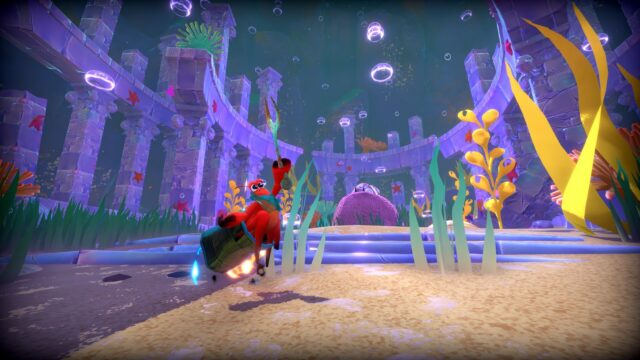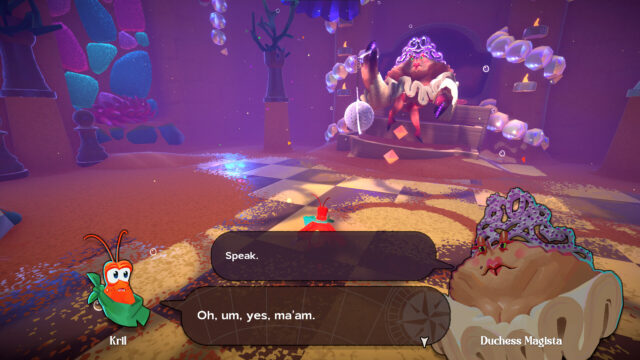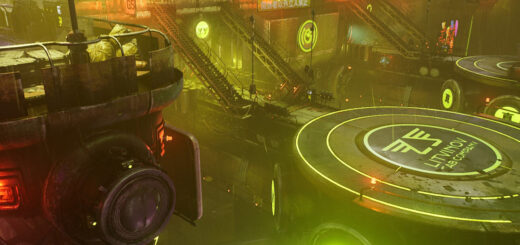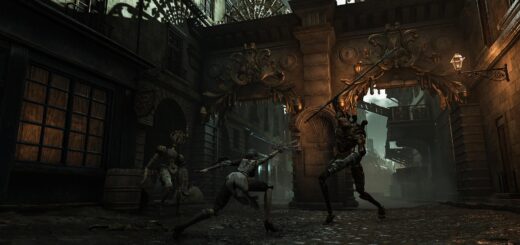Another Crab’s Treasure Review
Dark Shoals
Some games simply should not be judged by their covers. Case in point: Another Crab’s Treasure. Looking at screenshots or a trailer, it’s hard to imagine anything being more Disney-esque than a cute little hermit crab on a quest across the ocean floor to recover his shell. The premise alone will likely spark visions of The Little Mermaid or Finding Nemo in players’ minds. However, underneath the game’s cutesy exterior lies a tough, challenging game more akin to the darker fare Soulslikes have recently been serving up, such as Lies of P and Lords of the Fallen. While Aggro Crab Games’s aquatic offering to the genre isn’t 100% ready for the deep end of the pool, it is a competent and worthwhile outing for fans of the genre to dip their toes into.
The game places more emphasis on its story than is typical for this subgenre, introducing a colorful cast of supporting characters for its protagonist to get to know and interact with via dialog and cinematic scenes. It’s a far cry from the traditional tidbits of lore hidden in item descriptions that are the Soulslike’s bread and butter. Still, the gist of the story is quickly explained: Kril is a hermit crab who loves nothing more than basking in a shallow tidepool, safe and secure from menacing birds in his trusty shell — his love, his life, his one-and-only. Unfortunately for Kril, his precious shell is summarily confiscated in the game’s opening scene by a loan shark (the game doesn’t shy away from liberal uses of puns and wordplay) as a tax for the local duchess whom Kril is, apparently, a subject of. Though the narrative takes several twists and turns before the end credits roll, Kril’s motivation is the same throughout: reacquire his shell and return to his comfortable tidepool by any means necessary.
Of course, nothing comes for free in the deep blue sea, and Kril must face many dangers and powerful foes before all is said and done. This is a Soulslike, after all, though one geared towards solo play, with absolutely no multiplayer. Another Crab’s Treasure‘s combat system is relatively simple and easy to pick up, but offers a bit of variety to deal with some of its stronger foes. Kril is armed with a two-pronged snail fork, which is an appropriate touch considering the shell-toting baddies he’s up against. Apart from the occasional upgrade to its attack power, there’s little else to the game’s offensive options; Kril can string together a short combo of basic strikes or charge for a heavier hit. That’s because the game is largely about defensive play, and how to best turn the tide by using an enemy’s attack against them. Boss encounters in particular require players to become familiar with their attack patterns in order to pull off well-timed parries and counters, in the vein of games like Sekiro.
As a hermit crab, Kril is naturally adapted to crawling into objects and using them as a protective shell, and the game fully leans into this ability, making it the cornerstone the combat system rests on. Whether it be a soda can, Rubik’s Cube, boxing glove, or coconut, Kril can find nearly seventy unique objects to crawl into and hide within. The catch is that shells take damage when used defensively, and Kril can find himself unexpectedly vulnerable if a shell breaks at a critical moment, madly scrambling to find another shell on the double. However, these objects are generally in plentiful supply, and boss arenas are often littered with them. Each shell also has a unique spell associated with it, an inherent ability that costs Umami (the game’s magic points) to use. For example, the sushi roll doesn’t last long in a fight but can be consumed by Kril to earn back some lost health, while the tennis ball lets Kril roll at high speeds. It’s not a highly intricate magic system, but it has a good amount of flexibility and encourages aggressive play since magic points are recharged by dealing damage to enemies.
The shell system ties into the game’s emphasis on parrying, since a perfectly timed block negates any damage the shell would otherwise have taken. This becomes the key to many boss fights, since perfect blocks also increase the enemy’s stagger meter, eventually opening them up to some free damage. There are also unlockable skills that represent other staples of the genre, such as a riposte that can follow a perfect dodge, or a critical strike once an enemy is knocked off-balance (“capsized”, as the game calls it). There are a couple of special abilities that can be found or earned by defeating specific bosses that can be used during exploration to access hard-to-reach areas. Finally, players can find and attach Stowaways to their shell, minuscule sea creatures that grant boons to specific stats or abilities.
Not only are the game’s bosses a highlight in terms of combat, but they’re also some of the best examples of creative enemy design, particularly when it comes to taking advantage of the miniature scale of this crab-sized world. One early boss, for example, swings around a wire-mesh tea infuser on a chain like a flail, while another wields a U-shaped bike lock like a guillotine. A late-game boss even swings around a toilet brush. A personal highlight is Heikea, the Intimidation Crab, whose boss arena resembles a sushi board where he wields a pair of chopsticks that he slowly and menacingly unsheathes of its paper wrapper at the start of battle. Normal enemies, on the other hand, are more traditional ocean fare, and include a large variety of different-sized crabs as well as various fish and seahorses.
Environments, too, take advantage of the playful quality provided by the unique setting, though it initially feels like the designers held back a tad on this front. Early areas, when Kril is still pretty close to the surface and the shore, are littered with flip-flops, beach pails and shovels, popsicle sticks, and other debris that may have been carried away from a crowded beach. The issue is that all of this feels merely like so much window dressing, and the player quickly learns to just run past it. This issue lessens a bit as one progresses, with the designers evidently reaching further into their bag of aquatic tricks for later levels. By the late-game stages, areas are far more intricate, with shortcuts to open and plenty of nooks and crannies to explore. Similarly, the light-less depths Kril eventually reaches successfully convey a foreboding and eerily Lovecraftian atmosphere, with eldritch foes hiding in the pitch black water. Still, the urge to stop and marvel at the environments or inwardly giggle at cheeky area designs doesn’t come up as often as one would expect given the potentially rich underwater canvas the setting provides.

Early areas are lively and vibrant, but the deeper Kril goes, the less upbeat his surroundings become.
Another Crab’s Treasure definitely doesn’t outstay its welcome, with a thorough playthrough running around 20 hours. Despite the ability to fast-travel back to previous areas, and a handful of shortcuts that connect later areas back to earlier ones to boot, there is generally little reason to backtrack or stray too far from the beaten path. There are new skins for Kril to find and crystals — used as currency to unlock and upgrade skills — to collect in each zone, but it’s possible to max out all three of Kril’s skill trees well before reaching the game’s final boss. There are also next to no sidequests that would require more thorough exploration, save for one single instance where an optional NPC tucked away in a hidden cave needed Kril’s help. As it stands, however, the game is pretty much a straight shot from Point A to Point Z.
To present its narrative, Another Crab’s Treasure includes generally good voice acting, at least during its cinematic scenes. Kril, in particular, is performed spot-on as an exasperated crab who is continuously thrown one curveball after the next while the only thing he wants to do is go back home and rest. In all other respects, the game looks and sounds good, even if not much stands out as particularly noteworthy. The underwater effects work, and it is admittedly a cool touch to look up and see all types of marine life cruising the waters just below the surface. The music score accompanying the game’s early sections is suitably beachy, while later sections become more and more menacing and darkly foreboding.

The game breaks tradition a bit by presenting an actual narrative, complete with a cast of characters and dialogue.
While the game, by default, offers plenty of challenge, the designers have included a host of settings that can be adjusted to not only make it easier but, critically, less frustrating, particularly for players who are turned off by some of the core DNA inherent in Soulslikes. Difficulty — preset to Hard — can be lowered, as can damage taken and enemy health. Shells can be made more durable, and the windows for dodge invincibility and parrying can be made more forgiving. Most important, for those who find typical Soulslikes too frustrating, are options that remove fall damage or the permanent loss of the game’s base microplastic currency upon death. Finally, if all else fails, players looking for a Hail Mary option that removes combat difficulty altogether can toggle on a handgun that Kril can use as a shell, which one-shots any enemy in the game — even bosses — altogether.
Another Crab’s Treasure doesn’t reinvent the Soulslike wheel by any means. Rather than adding its own twists to the well-established formula, it instead doubles down on what has already been established, adopting a parry-heavy combat formula and pairing it with tried-and-true environmental exploration. It does, however, establish some unique ideas. Not only does the shell system tie in well with the game’s unique aquatic setting, but it also adds a good amount of flexibility for players to overcome obstacles. Allowing players to tweak many of the settings inherent to the genre further makes its otherwise fairly challenging campaign accessible to gamers of all skill levels. Coupled with a charming presentation and cast of characters, this could very well be the game that will bring new RPGamers into the Soulslike fold, making it a game that is well worthy of checking out for anyone with even a passing interest in the genre.
Disclosure: This review is based on a free copy of the game provided by the publisher.


A highly original addition to the Soulslike pool
Shell system adds a ton of flexibility to combat
Plenty of difficulty options to bring new players to the fold
Early areas aren't as fun to explore as later ones
Presentation fails to stand out in any meaningful way









Recent Comments